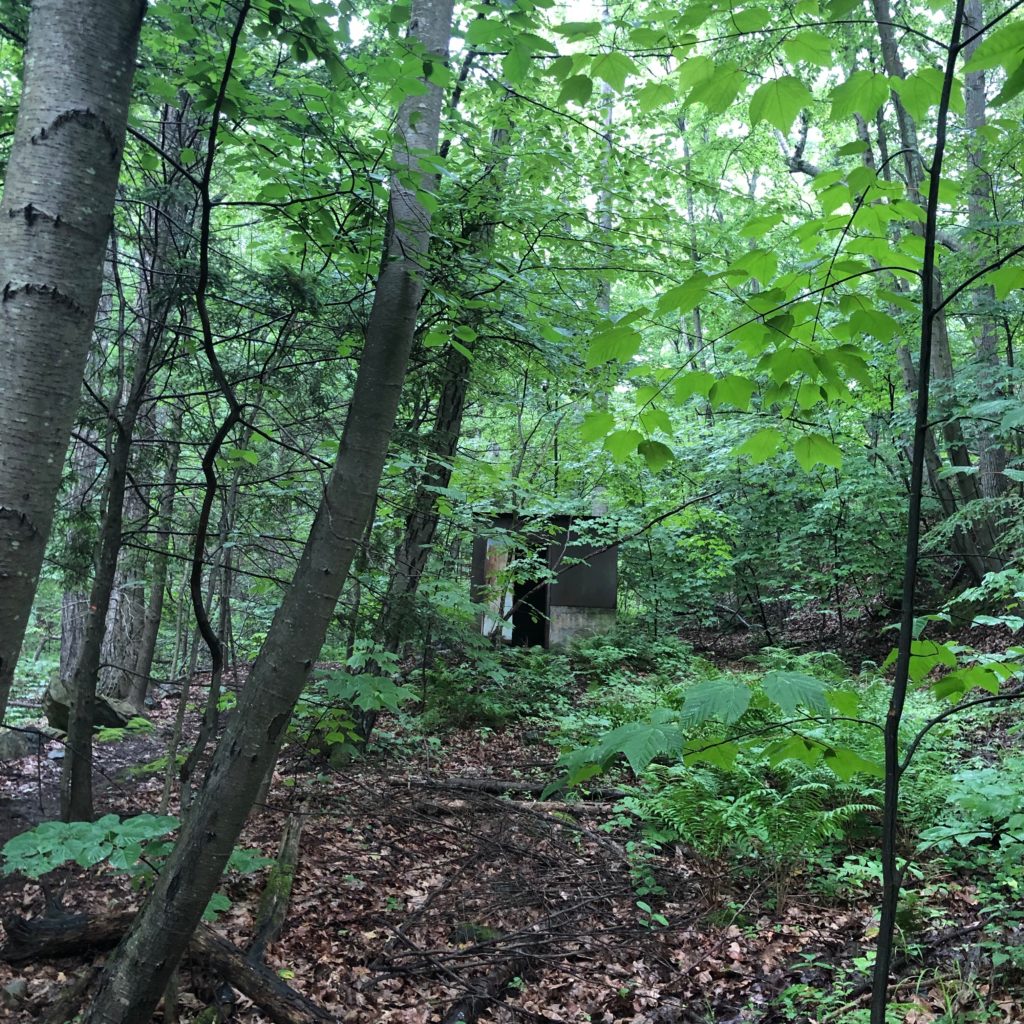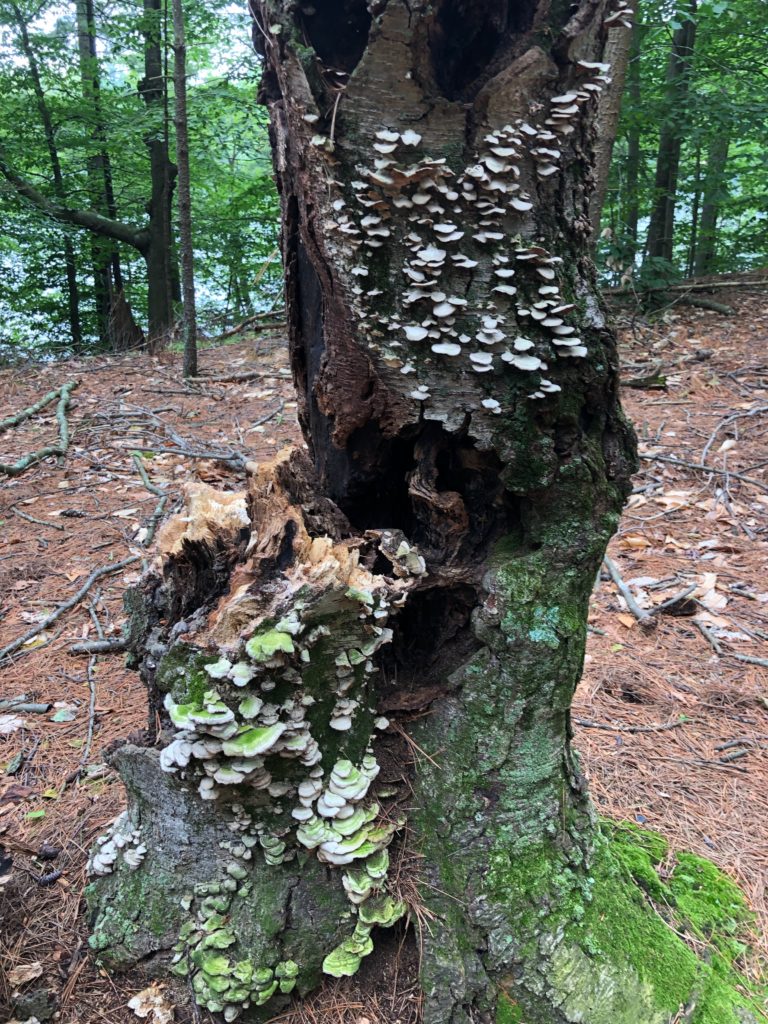Deer Jump Reservation, July 2019
The second walk in the Artist Walks (3) series created a context in which participating artists could consider the ethics of place, particularly the ethics of making a piece of art for a particular place.
On this woodland walk, participating artists moved together starting at the Albert R. Retelle wetlands reservation, past private residences, along a utility road, past a town water-pumping station, and into the Deer Jump Reservation. As we walked, we shared thoughts about creating artworks, experiences, and places that take into consideration the ethical implications of working in various natural and built environments.
At regular intervals along the walk, participants were given prompts to frame their contemplation and the subsequent discussion.

Ethics of Place Walk Prompts
Us
Who are we? What are the conditions of our access to this place? Are we here by invitation? Are we trespassing? Is there some quality of our being that gives us the permission or right to be here? Are we strangers here for the first time, regular occupants familiar with this place, or native inhabitants born of this place for generations? What are the circumstances of our presence here? Is this place a public, private, or privately-owned public space? Is what we might see, hear, smell, feel or do governed by some kind of formal or informal regulations? What are we doing? Do we pass unnoticed or draw attention to ourselves? Do we wear particular attire or behave in particular ways? Do we bring things with us or leave things behind?1
Patterns
To do creative work in shared places is also to challenge shared behavior patterns. In these places we contribute to social and cultural patterns. We reproduce and reinforce patterns that we have learned. We adapt and create new patterns that we then share. Can we ever be fully aware of these patterns? Can we ever be free of them? Can we reveal these patterns to those with whom we share this space? Can we put the old patterns to bed and then build whole new cultures together?2
There
Who is this place? What are its patterns, cycles, and structures? Does it have a man-made architecture or natural topography? Does its form suggest certain ways of moving through or across space? Does it have pools of stillness? How does light impact the shape of the place, does this change over time? Is there a prescribed location that is demarcated for our work? Or are there particular locations or spots in this place that seem more advantageous and welcoming? Are there traces left behind from others’ work, evidence of memories embedded in the place’s being? Can you see how the place has changed over time? Does the place have its own stories to tell? How will our work here impact the plants, animals, and other wildlife or the architectural preservation of this place? How will our audiences impact the environment/preservation of this place?
Meaning
“The landscape is never devoid of meaning, even when it is deserted. The landscape is a social map whose legend you must learn. The human body and the body of the land share a common language. Person and place coalesce. Whatever happens to the one, happens to the other.”3
One might argue that the architectural goals of the gallerist’s pristine white cube or the contemporary presenter’s ‘flexible’ black box is to create a place wherein the artist can control all the meaning that is created. As if a blank canvas carried no meaning in itself. In the landscape, in the public site, in a home, the artist can harbor no such illusions. The work one makes in these sites must enter into conversation with its context, with the social map of the people, animals, plants, and things that inhabit that space and are out of the artist’s control. Art and place will coalesce, creating their own meaning. How might the artist teach the legend to others?
Change
Everything changes. Everything evolves and adapts, albeit in different ways, at different speeds, and driven by different forces. Places cherish this principle of continual change. Nothing is permanent in form or substance, nothing truly fixed. Everything is part of a dynamic process. When we understand this about a place, it becomes alive. Does imagining a place as alive change your approach to working in it? Does it make you more likely to approach the site with a kind of sacred care? Or does it make you less fearful of radically altering the place with your creative touch?4
Remember, this is home to someone
How might you work differently if you paused to remember that every place is “home” to someone? That any place can provide a sense of rootedness, safety, and warmth. Close your eyes and think of a place that makes you feel at home, a place to which your thoughts often return and find refuge. For many of us it is not the house we live in, but a place out in the world where we find the people, nature, or horizons that give us that sense of well-being we seek. Now imagine a stranger arriving in that place and changing it, disrupting its shape, contents, or rhythms. Imagine them making images of their home in that place. Does this excite you, anger you, make you nervous? Do you wish the stranger had asked you first or given you some warning of their plans? Do you accept that your home is temporary and transient, adapting to the changes or moving on to find a new one?5
Them
Who is our audience? What are the conditions of their access to this place? Are they strangers, here for the first time at our invitation? Are they regular occupants, familiar with this place and holding certain expectations of what they will find here? Are they wardens, caretakers, or native inhabitants of this place, concerned with its welfare and sustainability for generations to come? Does their livelihood depend on this place and their ability to access it? What might they do under normal circumstances in this place? Do they behave in particular ways? Do their activities have any relationship to time, day, or weather? What have they done here in the past? Are they used to the presence of artists in this place? How might they feel about this place? Does our presence disrupt their experience of this place in some way? Do they welcome our presence here or the presence of some remnant we may leave behind? Or does our presence challenge them?
We should give more than we take6
What kind of relationship do you wish to create with this place? What kind of relationship do you wish to create with others in this place? Do you want to seduce and enchant them? Do you want to help them stitch themselves back into the social weave? Do you want to shock and awe them? Do you want to engage them in a social practice of community transformation? Do you want to disrupt their expectations and unsettle their beliefs? Do you care about them at all? What is the ecology of relationships you wish to disrupt, adapt or create in this place? As an artist, can you imagine a way of being in relation to this place and the people in it that doesn’t put you at the center, doesn’t coerce their attention, doesn’t set you up as the author of experience?
Pride of Ownership
“Art has the power to create experiences and phenomenological effects… This is why an artwork needs a visitor, and why art in public spaces has such potential power… The people of the region express support by brining tea and rice balls to visitors, and in various other ways. As a result, the artwork is not the work of the artist alone but shared by many people. It is a true collaboration…It is also enlivening when local residents explain an artist’s process to visitors. Art is meant to be experienced in the site where it is located and in the surrounding context. This exchange is what moves people, speaks to people, and engages people.”7
What if the artist’s task wasn’t just to make the artwork, but also to create a sense of ownership and pride in the artwork amongst residents local to the place where the artwork will reside? To develop a community of locals who will nurture and care for both the artwork and the visitors when the artist is not there? How might that way of thinking change the way you go about making your art?

Footnotes
1) adapted from Mike Pearson, Site-Specific Performance, p 19
2) adapted from writings about the body in SU-EN’s Body and the World, p 70
3) Michael Jackson, At Home In The World, p125
4) adapted from writings about the body in SU-EN’s Body and the World, p 75
5) Referencing Jane Blocker, Where is Ana Mendieta? Identity, Performativity, and Exile, p 99 & 106 as well as Michael Jackson, At Home In The World, p 3, 66, & 85
6) title is a quote from Leanne Betasamosake Simposon, As We Have Always Done: Indigenous Freedom through Radical Resistance, p 9
7) Fram Kitagawa, Art Place Japan: The Echigo-Tsumari Triennale and the Vision to Reconnect Art and Nature, p14-15